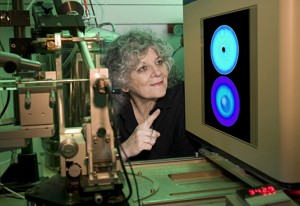Ada E. Yonath was born in Jerusalem in 1939 to a poor family. As a child, she actively investigated the world around her and took an interest in her father’s medical conditions. Her parents enabled her to obtain a formal education at prestigious secular grammar school Beit Hakerem.
At the age of 11, Ada’s father died and she began to do odd jobs to help support her family. Her family moved to Tel Aviv, where she was able to complete her high school education. Ada then served compulsory army service in the Medical Forces and, later, enrolled at the Hebrew University of Jerusalem where she earned her master’s degree in chemistry, biochemisty, and biophysics. She completed her doctorate at the Weizmann Institute, working on the high-resolution structure of collagen. She completed postdoctoral research on fibrous proteins (muscles) in the United States.
In the 1970s, Ada established the first biological crystallography laboratory in Israel at the Weizmann Institute. She aimed to used the laboratory to study the process of protein biosynthesis and determine the three-dimensional structure of ribosome (where instructions written in genetic code are turned into proteins). It took her over two decades to complete her research, during which she came to lead a large team of researchers from all over the globe.
Ada’s research led to a detailed understanding of the actions of some of the most widely prescribed antibiotics, as well as the first ribosome micro crystals that revealed the three-dimensional structure of ribosomes. Her findings will aid in the development of more efficient antibiotics and give scientists new weapons in the fight against antibiotic-resistant bacteria. For her work, she was awarded the Nobel Prize in 2009.
And what does the future hold for Ada? As she states, “We plan on looking to the distant past. Ribosomes are found in every living being – from yeast and bacteria to mammals – and the structures of their active sites have been extraordinarily well-preserved throughout evolution.” Ada and her team will be looking back in time, to find the first ribosomes that came into being and, in turn, how ribosomes helped give rise to life.

